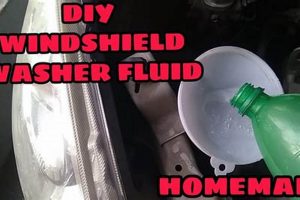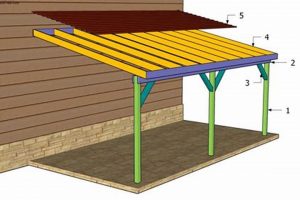An establishment providing the space, tools, and often, guidance, necessary for individuals to perform maintenance and repairs on their own vehicles constitutes a self-service automotive facility. This model departs from traditional mechanics’ garages, placing the onus of labor on the vehicle owner while offering resources otherwise inaccessible at home.
The significance of such businesses lies in the cost savings they afford to individuals capable of performing auto work. Furthermore, they offer a learning environment for those seeking to expand their knowledge of automotive mechanics. Historically, these spaces have become prevalent as an alternative to expensive professional labor, appealing to budget-conscious vehicle owners and hobbyists.
The following sections will delve into the specific types of equipment typically available, the range of services commonly undertaken in these facilities, and the essential safety considerations for patrons choosing this route for vehicle maintenance and repair.
Optimizing the Self-Service Automotive Facility Experience
Maximizing the potential of a do-it-yourself automotive repair environment requires careful planning and adherence to best practices. The following points highlight strategies for effective vehicle maintenance within such a facility.
Tip 1: Prior Preparation is Paramount: Before commencing any work, research the specific repair required. Consult repair manuals, online forums, and video tutorials to gain a thorough understanding of the process. Identify required tools and replacement parts, ensuring their availability before reserving a bay.
Tip 2: Tool Inventory and Familiarization: Take time to become acquainted with the available equipment. Understand the functionality of each tool and its proper application. Inquire about the location of specialized tools and any operational guidelines.
Tip 3: Safety First: Adherence to safety protocols is non-negotiable. Utilize safety glasses, gloves, and appropriate footwear. Ensure the vehicle is properly supported on jack stands before working underneath. Familiarize oneself with the location of emergency exits and fire extinguishers.
Tip 4: Meticulous Organization: Maintain a clean and organized workspace. This minimizes the risk of lost tools and parts, streamlining the repair process. Clearly label removed components to facilitate reassembly.
Tip 5: Waste Disposal Compliance: Dispose of used oil, fluids, and parts according to facility regulations. Improper disposal can lead to environmental contamination and potential fines. Locate designated receptacles and adhere to established protocols.
Tip 6: Documentation and Photography: Document each step of the repair process with photographs. This serves as a valuable reference during reassembly and aids in troubleshooting potential issues. Keep detailed notes regarding torque specifications and wiring configurations.
Tip 7: Seek Guidance When Needed: Do not hesitate to seek assistance from on-site staff. They can provide valuable insights, guidance, and support. Leveraging their expertise can prevent costly mistakes and ensure a successful repair.
Adherence to these guidelines promotes a safer, more efficient, and ultimately more rewarding experience in a self-service automotive setting. Diligence and foresight are key to successful vehicle maintenance within this framework.
The subsequent section will address common challenges encountered in these facilities and strategies for their mitigation.
1. Affordable Access
Affordable access serves as a core value proposition for the do-it-yourself auto repair shop concept, significantly impacting its appeal and viability within the automotive service market. This affordability extends beyond simple price comparisons, encompassing a holistic reduction in expenses associated with vehicle maintenance and repair.
- Reduced Labor Costs
The primary driver of affordability stems from the elimination of professional labor charges. Patrons assume the responsibility for performing the repairs themselves, thereby avoiding the substantial costs associated with hiring certified mechanics. This translates to significant savings, particularly for complex or time-consuming procedures.
- Transparent Pricing Structure
DIY repair shops typically operate on a transparent, hourly rental basis. This straightforward pricing model allows customers to accurately predict and control their expenses. Unlike traditional repair shops where labor costs can be opaque and subject to unforeseen charges, the self-service approach promotes financial clarity and predictability.
- Phased Repair Opportunities
Affordable access enables vehicle owners to tackle repairs in stages, aligning with their budgetary constraints. Repairs can be broken down into manageable segments, allowing for gradual component replacement and preventing the accumulation of overwhelming expenses associated with comprehensive, immediate overhauls.
- Learning and Skill Acquisition
The cost savings associated with DIY repair can be viewed as an investment in skill development. The learning process inherently contributes to increased vehicle maintenance proficiency. This newfound ability translates into long-term savings and reduces dependence on professional mechanics for routine maintenance tasks.
The aspects of reduced labor costs, transparent pricing, phased repair opportunities, and skill acquisition collectively illustrate the multifaceted nature of affordable access in the context of the do-it-yourself auto repair shop. This affordability, coupled with the availability of tools and workspace, empowers vehicle owners to maintain and repair their vehicles at a significantly lower cost than traditional alternatives, fostering a sense of autonomy and financial empowerment.
2. Tool Availability
The operational model of the do-it-yourself auto repair shop fundamentally relies on the provision of a comprehensive array of tools. A direct correlation exists between the breadth and quality of tool availability and the functionality of these businesses. The absence of necessary tools effectively nullifies the self-service aspect, rendering the facility unusable for its intended purpose. The presence of specialized tools unavailable to the average vehicle owner at home constitutes a primary draw for patronage. Examples include, but are not limited to, diagnostic scan tools, hydraulic lifts, wheel balancing equipment, and specialized engine repair instruments. The ability to access these tools is a critical factor influencing a customer’s decision to utilize a self-service facility instead of attempting repairs at home or outsourcing to a traditional mechanic. Without appropriate tooling, the intended cos
t savings and learning opportunities are unrealized.
Adequate tool availability extends beyond mere presence to encompass maintenance and organization. Consistently calibrated and well-maintained equipment ensures accurate and safe operation, preventing damage to vehicles and injuries to users. Strategic organization within the facility promotes efficiency, minimizing the time spent searching for specific tools and maximizing the time dedicated to actual repair work. For example, a self-service shop offering advanced diagnostic tools but failing to provide training on their proper use limits the benefit to experienced users only. Conversely, a shop providing comprehensive training alongside a range of tools widens accessibility to a broader spectrum of vehicle owners.
In summary, tool availability is not merely an accessory to the diy auto repair shop model but rather an intrinsic component defining its viability. Its significance rests on providing access to equipment otherwise unattainable, ensuring maintained and calibrated tools for safe operation, and offering support and training for effective use. The success of this business model hinges on the thoughtful procurement, maintenance, and accessibility of a comprehensive range of tools catering to diverse automotive repair needs. The challenges of inventory management and user training represent ongoing considerations for proprietors seeking to optimize the efficacy of their facilities.
3. Workspace Provision
Workspace provision constitutes a fundamental pillar of the self-service auto repair shop model. The availability of designated, adequately equipped workspaces distinguishes these facilities from simple tool rental operations. These workspaces provide a safe and organized environment conducive to performing automotive maintenance and repairs, addressing limitations often encountered in residential settings. Without adequate space, even the most skilled mechanic would be impeded, highlighting workspace provision as a critical enabler of the DIY concept.
Consider the example of a clutch replacement. This procedure typically necessitates a level of workspace unattainable in a standard residential garage or driveway. Sufficient lighting, a flat, level surface, and ample room to maneuver around the vehicle are essential for safe and efficient completion. The presence of a hydraulic lift further enhances accessibility and ergonomic positioning, reducing strain on the individual performing the work. The provision of such a workspace directly impacts the feasibility and quality of the repair undertaken. For instance, a shop offering poorly lit, cramped bays with uneven flooring would inherently limit the scope of projects that patrons could realistically undertake.
In summary, workspace provision is not merely an ancillary feature of the do-it-yourself auto repair shop. Instead, it is an integral component that enables patrons to perform a wider range of repairs safely and effectively. The quality and suitability of the workspace directly influence the functionality and appeal of these establishments. Challenges related to space optimization and equipment integration are ongoing considerations for shop operators seeking to maximize patron satisfaction and operational efficiency.
4. Technical Assistance
Technical assistance represents a crucial element differentiating a mere tool rental facility from a comprehensive self-service automotive repair environment. While the provision of space and equipment forms the foundation of the concept, the availability of knowledgeable personnel to offer guidance and support significantly enhances the user experience and expands the range of repairs that can be successfully undertaken. The presence, or absence, of technical assistance directly impacts the safety, efficiency, and ultimate success of a patron’s endeavor. A patron attempting a complex repair, such as engine timing, may encounter unforeseen difficulties. In the absence of available technical support, this situation can lead to project abandonment, potential damage to the vehicle, and patron dissatisfaction. Conversely, readily accessible assistance enables problem resolution and project completion.
The form technical assistance takes can vary, encompassing on-site mechanics offering advice, instructional workshops on specific repair procedures, or access to detailed repair manuals and diagnostic databases. Consider a patron struggling to interpret diagnostic codes generated by an engine scan tool. Without the expertise to correlate these codes with potential mechanical issues, the tool’s utility is limited. Technical assistance, in this instance, could involve a mechanic explaining the code’s meaning and guiding the patron toward relevant troubleshooting steps. Another example could be a workshop demonstration on brake pad replacement, where a qualified instructor demonstrates the correct procedure and answers questions from participants, ensuring safety and proper installation.
In summary, technical assistance serves as a linchpin in the self-service automotive repair model. It bridges the gap between tool availability and practical application, empowering patrons to confidently tackle a broader spectrum of repairs. Challenges associated with providing adequate and qualified personnel necessitate careful consideration for shop operators aiming to optimize the value proposition of their facilities. Prioritizing training for staff and investing in readily accessible resources for patrons are essential steps in ensuring that technical assistance effectively contributes to the success and sustainability of the DIY auto repair shop.
5. Community Resource
The designation of a do-it-yourself auto repair shop as a community resource extends beyond its functional role of providing tools and workspace. It represents an environment fostering social interaction, skill sharing, and collaborative problem-solving, benefiting both individual patrons and the broader community.
- Skill Sharing and Mentorship
DIY facilities often become hubs for experienced mechanics and novices alike. The informal atmosphere encourages the exchange of knowledge and techniques, transforming the space into a learning environment. Experienced patrons may offer guidance to those less familiar with specific repair procedures, fostering a sense of mentorship and collaborative problem-solving. This organic transfer of skills elevates the overall mechanical aptitude within the community.
- Cost Savings and Economic Empowerment
By providing affordable access to tools and workspace, self-service auto repair shops empower individuals to maintain and repair their vehicles at a fraction of the cost associated with professional services. This cost savings can be particularly significant for low-income individuals and families, freeing up resources for other essential needs. The ability to perform one’s own vehicle maintenance translates directly to economic empowerment and increased financial stability.
- Community Building and Social Interaction
The shared experience of working on vehicles fosters a sense of camaraderie among patrons. Individuals often engage in informal conversations, exch
anging tips, and assisting one another with challenging tasks. This social interaction builds community bonds and creates a supportive network of individuals with shared interests. The shop becomes more than just a place to repair cars; it transforms into a social hub where friendships are forged and a sense of belonging is cultivated. - Promotion of Automotive Literacy and DIY Culture
Self-service auto repair shops contribute to the promotion of automotive literacy and the growth of a DIY culture. By providing access to tools, resources, and expertise, these facilities encourage individuals to become more knowledgeable about their vehicles and to embrace the challenge of performing their own repairs. This increased understanding empowers vehicle owners to make informed decisions about maintenance and repair, reducing their reliance on potentially unscrupulous mechanics and fostering a sense of self-sufficiency.
These facets illustrate that the function extends well beyond simply making car repairs. It nurtures social ties, supports local financial security, and raises levels of auto literacy. Thus, a DIY garage is a powerful community asset.
Frequently Asked Questions
This section addresses common inquiries and concerns regarding the utilization of self-service automotive repair facilities. The information provided aims to offer clarity and guidance for prospective patrons.
Question 1: What prior experience is necessary to effectively utilize a DIY auto repair shop?
While no formal certification is required, a basic understanding of automotive mechanics is beneficial. Individuals with limited experience are advised to begin with simpler tasks and consult available resources before undertaking complex repairs.
Question 2: What types of tools and equipment are typically available at these facilities?
Most DIY auto repair shops provide a range of tools, including standard hand tools, power tools, diagnostic scan tools, hydraulic lifts, and welding equipment. Specific tool availability may vary by location; therefore, confirmation is advised before commencing work.
Question 3: Are there safety regulations or guidelines that must be followed within the shop?
Strict adherence to safety regulations is mandatory. Patrons are required to utilize safety glasses, gloves, and appropriate footwear. Vehicles must be properly secured on jack stands before any work is performed underneath. Familiarization with emergency procedures is essential.
Question 4: What provisions are in place for the disposal of used oil and other hazardous materials?
DIY auto repair shops typically provide designated receptacles for the proper disposal of used oil, coolant, and other hazardous materials. Patrons are responsible for adhering to disposal guidelines to prevent environmental contamination.
Question 5: Is technical assistance available to patrons who encounter difficulties during a repair?
Many facilities offer on-site technical assistance in the form of experienced mechanics who can provide guidance and advice. The level of assistance may vary, and patrons are encouraged to inquire about available support before commencing work.
Question 6: What is the pricing structure typically employed by DIY auto repair shops?
The majority of facilities operate on an hourly rental basis for bay usage. Some may offer additional charges for specific tools or services. Understanding the pricing structure is crucial for managing expenses effectively.
Key takeaways: DIY auto repair shops provide a cost-effective alternative to traditional repair services. Adherence to safety protocols, proper waste disposal, and effective management are very important.
The subsequent section will delve into the legal and insurance aspects of operating a self-service automotive repair facility.
DIY Auto Repair Shop
This analysis has explored the multifaceted nature of the diy auto repair shop concept, delineating its core elements: affordable access, tool availability, workspace provision, technical assistance, and its role as a community resource. It has further addressed common inquiries and concerns, emphasizing safety protocols and responsible waste disposal practices. The efficacy of this business model hinges upon a commitment to providing accessible, well-maintained resources and fostering a safe, supportive environment for patrons.
The continued viability and expansion of the diy auto repair shop sector depend upon ongoing adaptation to evolving technological advancements in the automotive industry, and stringent adherence to all applicable regulations. Prudent management, coupled with a dedication to customer service and safety, are essential for the long-term success and sustainability of this unique service model. Further research and due diligence are advised for those considering either establishing or utilizing such a facility.



![Diya Aur Baati Hum: Illuminate Your Home [DIY Guide] The DIY Hub: Creative Crafts, Repairs & Life Hacks Diya Aur Baati Hum: Illuminate Your Home [DIY Guide] | The DIY Hub: Creative Crafts, Repairs & Life Hacks](https://craftingdiycenter.com/wp-content/uploads/2025/07/th-5913-300x200.jpg)



